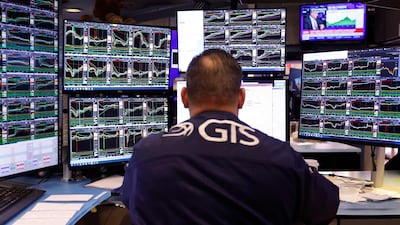Stock markets in the US tested new highs last week and are expected to remain bullish in the coming months, as positive investor sentiment builds on hopes of a Federal Reserve interest rate cut in June.
Amid a healthy US earnings season, stocks have not really responded to last week's sell-off in Treasury markets, hotter-than-expected consumer price index data or producer price index readings.
CPI, a key measure of US inflationary conditions, came in higher than expected at 3.1 per cent year-on-year, above the expected 2.9 per cent.
Year-on-year core CPI, the same metric but excluding food and energy, also ticked higher to 3.9 per cent, just above the expected 3.7 per cent.
The PPI metric – which measures the change in prices of goods sold by manufacturers – also increased across the board.
While equities corrected in the immediate short term on these figures – the S&P 500 dropped more than 1.3 per cent on February 13 – their performance in the days after was encouraging.
Investors absorbed the news better than expected and this means that risk factors have not moved much in overall sentiment.
Even the S&P's lower closing of 0.5 per cent on Friday seems like a minor correction, all things considered.
A quick check of the CME’s FedWatch tool shows that while the Federal Open Market Committee's meeting in March will undoubtedly yield a hold in rates, the possibility of a cut at its June meeting has increased to 51.6 per cent – up from 41.9 per cent from a week ago (before the CPI and PPI prints were released).
Markets are taking on more momentum for a cut in June – and one could argue the recent rally in US equities backs this up.
This would mean the bullish moves in US equities will continue, albeit we could see some uneven pricing action and minor corrections on a daily basis, similar to that of last week.
Overall, US earnings are positive and this should continue to lend support to markets and risk-on sentiments.
However, on the flip side, it is important to note that geopolitical risks – from the ongoing Middle East turmoil and Red Sea volatility – could weigh on sentiment.
More companies have been addressing these geopolitical issues during earnings calls with analysts and investors in the first quarter.
Through to the end of February and the early parts of March, I will be keeping an eye out for any minute details and changes in wording from the FOMC meeting minutes that are due on February 21 at 11pm UAE time.
Any comments perceived to be hawkish would see weakness in risk modes, which would eventually lead to more US dollar buyers and higher Treasury yields.
Weekly jobless claims are due on February 22, at 5.30pm UAE time, and are expected to show slight increases.
On February 28, we have US gross domestic product data (due at 5.30pm UAE time). This will precede the all-important personal consumption expenditure print at 5.30pm on February 29.
The PCE is the Fed’s preferred measure of inflation. Year-on-year PCE in December came in at 2.6 per cent, while core PCE, which excludes food and energy, came in at 2.9 per cent.
Any slight increase in these prints and currencies will fall against the greenback, while gold should also come under pressure.
Again, equities would also feel the pressure short term, but longer term it should not hinder the bullish upwards bias.
Considering this, longer-term traders would need to wait before accumulating positions, while shorter-term traders may find some opportunity amid the coming data points.
Gold looks to hold above $1,974 through to the end of the first quarter, while I see upsides capped at $2,060.
If we turn to currency markets, EUR/USD looks to be under pressure technically in the short term.
I expect to see a conclusive test of 1.06 levels before the end of the first quarter, while upsides will be capped at 1.08.
Fundamentally, there is nothing supporting euro forecasts in the interim.
Expect to see new highs in US equities through to the end of February.
While it could get a little bumpy, I expect the S&P 500 index to make a run towards 5,300 before the end of March.
Gaurav Kashyap is a risk manager at Equiti Securities Currencies Brokers. The views and opinions expressed in this article are those of the author and do not reflect the views of Equiti Securities Currencies Brokers


